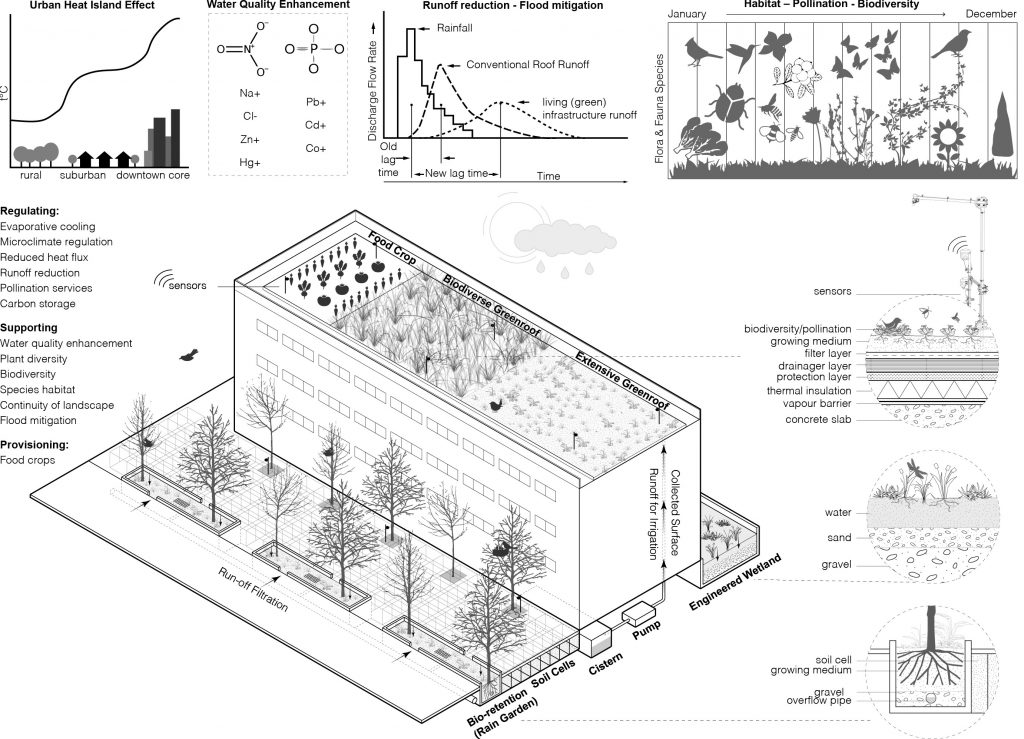
Growing media amendments to improve LI functionality
Drake, Margolis, MacIvor and Sleep; Thomas and McDonnell
LI growing media has been engineered following guidelines that focus almost exclusively on system hydraulics and water quality while neglecting the role of vegetation in a system’s water balance and the ecological functions of LI. Drake, Margolis, MacIvor and Sleep’s research at GRITlab has demonstrated the advantages of multifunctional LI that is designed and operated to maximize landscape, engineering and ecology goals. Biochar is a promising amendment that can increase the plant-available water in LI, reducing irrigation requirements and plant stress, while simultaneously improving stormwater quality. The biochar industry is rapidly growing throughout Ontario and Western Canada but its use as an amendment in LI media has been limited to a handful of studies on green roofs. Thomas and McDonnell are well connected with biochar suppliers (e.g. Titan Bioenergy, BioForest Technologies), and have expertise in growing media design and optimization. Trainees will be involved in testing biochar amended green roofs at the GRITlab and USask labs to understand how this amendment can improve LI performance considering design variables including climate, roof slope, biochar source and structure, and planting type; student research projects will extend this approach to bioretention systems and other LI components. Industry partners such as Gro-Bark, Titan Bioenergy, BioForest Technologies will contribute materials for lab and field studies.
Smart sensor systems and adaptive management of LI
Joksimovic, Drake and Sleep
One of the driving motivations for investment in LI is stormwater management. LI manages stormwater near to its source providing opportunities for quantity (through evapotranspiration, infiltration, detention and retention) and quality control (through filtration, sorption, biodegradation, plant uptake and more). LI is most effective when stormwater is retained on site for as long as possible. Adaptive or ‘smart’ outlet and irrigation controls allow for operations to be automated and flexible. Integration with weather forecasting information will allow for storage and release of water from LI systems just-in-time to receive inflow from an incoming storm system. Adaptive irrigation controls can also be used to adjust water supply during periods of drought ensuring plants have sufficient water while avoiding undesirable over-watering. OptiNimbus integrates cloud-based technology, sensors and flow controls to provide adaptive stormwater management. OptiRTC’s technology has been applied successfully to stormwater management ponds and sewers to reduce flooding and combined sewer overflows but has not been applied to LI. Joksimovic, Drake and Sleep’s trainees will collaborate with SideWalk Labs and OptiRTC to develop programming for LI applications and will trial the technology at Sidewalk’s planned QuaySide neighbourhood in Toronto.
Scaling up and enhancing ecological functionality of LI
MacIvor, Isaac, Lundholm, Joksimovic, Thomas, Drake, Margolis, Darko and Sleep
As living systems, LI is inherently dynamic and continuously evolving and changing. As systems age and mature ecological and physical functionality change. In the reality of increased densification and urban growth combined with a changing climate it is critical that LI systems become resilient, adaptive and multi-functional infrastructure. Much is unknown as to the compounding effects LI has on urban ecology, stormwater, heat islands and even public health. Trainees with MacIvor, Isaac and Lundholm will use the multiinstitutional infrastructure of the network to explore the contributions of LI to urban biodiversity; trainees with Joksimovic and Thomas will assess LI feedbacks with radiation, energy balance, and urban heat island mitigation. They will also examine the role of nutrient dynamics in the long-term sustainability of LI, and test applications of nitrogen fixer associated plants, mosses and lichens on soil stability and nutrient availability. Partnering with government organization such as STEP and the City of Toronto trainees with Drake, Margolis, Darko and Sleep will develop decision support systems for building retrofit projects to facilitate multi-objective design of LI.